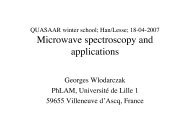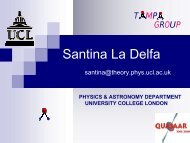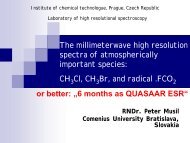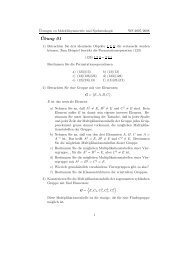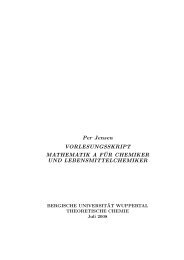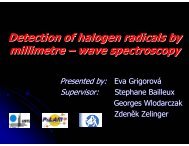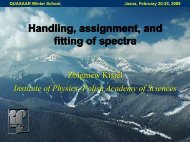Abstract book - Prof. Per Jensen, Ph.D. - Bergische Universität ...
Abstract book - Prof. Per Jensen, Ph.D. - Bergische Universität ...
Abstract book - Prof. Per Jensen, Ph.D. - Bergische Universität ...
- No tags were found...
You also want an ePaper? Increase the reach of your titles
YUMPU automatically turns print PDFs into web optimized ePapers that Google loves.
198 Poster session, J35Line position and line intensity analyses of the high-resolutionspectrum of the water molecule up to the first hexadM.-A. Martin-Drumel, 1 O. Pirali, 1 Manfred Birk, 2 Georg Wagner, 2 andL. H.Coudert 3Martin-Drumel M.-A.Pirali O.Birk M.Wagner G.Coudert L.H.1 Ligne AILES – Synchrotron SOLEIL, L'Orme des Merisiers, Saint Aubin, 91192 Gif-sur-Yvette, France, marie-aline.martin@synchrotron-soleil.fr; 2 Deutsches Zentrum für LuftundRaumfahrt e.V., Institut für Methodik der Fernerkundung, Wessling, 82234Germany, manfred.birk@dlr.de; 3 LISA, CNRS/Universités Paris Est Créteil et ParisDiderot, France, laurent.coudert@lisa.u-pec.frUsing the same ideas as in previous investigations, 1 a theoretical treatment is developedto account for the rovibrational energies of water up to the first hexad. The theoreticaltreatment is based on the exact Hamiltonian of a triatomic molecule written using Radaucoordinates. The potential energy function is expressed with the analytical formintroduced by Partridge and Schwenke. 2 <strong>Ph</strong>enomenological terms written as the productof vibrational and rotational operators are added to the Hamiltonian to account for thefact that the energy level calculation is not fully converged. This allows us to decreasethe size of the matrices to be diagonalized and the spectroscopic constantscorresponding to these phenomenological terms are determined by fitting highresolutionexperimental data.The new theoretical approach has first been applied to the fitting of a large body of dataconsisting of experimental energy levels 1 and transitions involving vibrational states upto the first hexad. This second data set includes room temperature infrared (IR)transitions 3 and far infrared (FIR) transitions recorded at high temperature with amicrowave discharge. 4 In its present state, the new theoretical approach allows us toaccount for 6608 data with a unitless standard deviation of 1.8, using 165 spectroscopicparameters. A line intensity calculation has also been performed and allows us to build aline list which will be used to further assign the FIR emission spectrum and an IRabsorption spectrum recorded at DLR with a high temperature of 1000 K in the 1550 to2300 cm −1 region.In the poster, the new theoretical approach will be described and the results of the fitswill be given. The new transitions assigned in the FIR and IR spectra will be presented.The line list deduced from the results of the analysis will be compared to available linelists.[1] Lanquetin, Coudert, and Camy-Peyret, J. Molec. Spectrosc. 206, 83, 2001; Coudert,Pirali, Vervloet, Lanquetin, and Camy-Peyret, J. Molec. Spectrosc. 228, 471, 2004;Coudert, Wagner, Birk, Baranov, Lafferty, and Flaud, J. Molec. Spectrosc. 251, 339,2008.[2] Partridge and Schwenke, J. Chem. <strong>Ph</strong>ys. 106 4618, 1997.[3] Toth, Applied Optics 33, 4851, 1994; Mikhailenko, Kassi, Wang, and Campargue, J.Molec. Spectrosc. 269, 92, 2011.[4] Martin-Drumel, Pirali, Balcon, Bechignac, Roy, and Vervloet, Rev. Sci. Instr. 82,113106, 2011.




